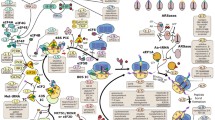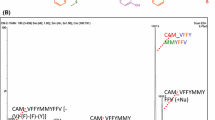Abstract
Cyclopiazonic acid is a toxic metabolite of fungal origin that inhibits protein synthesis in intact HeLa cells and eukaryotic cell-free systems. It has been shown that cyclopiazonic acid blocks the GTP- and EF-1-dependent binding of (3H)Phe-tRNA to 80S ribosomes. Moreover the translocation of N-Ac-(3H)Phe-tRNA by 80S ribosomes that takes place in the presence of EF-2 and GTP is also halted by cyclopiazonic acid. It is concluded that this drug affects a ribosomal site involved in the alternative interaction of elongation factors EF-1 and EF-2.
Similar content being viewed by others
Literature Cited
Carrasco, L., Barbacid, M., Vázquez, D. 1973. The trichodermin group of antibiotics, inhibitors of peptide bond formation by eukaryotic polysomes. Biochimica et Biophysica Acta312:368–376.
Carrasco, L., Jiménez, A., Vázquez, D. 1976. Specific inhibition of translocation by tubulosine in eukaryotic polysomes. European Journal of Biochemistry64:1–6.
Carrasco, L., Vázquez, D. 1973. Differences in eukaryotic ribosomes detected by the selective action of an antibiotic. Biochimica et Biophysica Acta319:209–215.
Carrasco, L., Vázquez, D. 1973. Ribosomal sites involved in the binding to aminoacyl-tRNA and EF-2: mode of action of fusidic acid. FEBS Letters32:152–156.
Holzapfel, C. W. 1968. The isolation and structure of cyclopiazonic acid, a toxic metabolite ofPenicillium cyclopium Westling. Tetrahedron24:2101–2119.
Jiménez, A., Carrasco, L., Vázquez, D. 1977. Enzymic and nonenzymic translocation by yeast polysomes: sites of action of a number of inhibitors. Biochemistry16:4727–4730.
Jiménez, A., Sánchez, L., Vázquez, D. 1975. Simultaneous ribosomal resistance to trichodermin and anisomycin inSaccharomyces cerevisiae. Biochimica et Biophysica Acta383:427–434.
Modolell, J., Vázquez, D. 1975. Polypeptide chain elongation and termination, pp. 137–178. In: Arnstein, H. R., (ed.), MTP international review of science, Biochemistry, Vol 7: Synthesis of amino acids and proteins, Oxford: Medical and Technical Publishing Co.
Neth, R., Monro, R. E., Heller C., Battaner, E., Vázquez, D. 1970. Catalysis of peptidyl transfer by human ribosomes and effects of some antibiotics. FEBS Letters6:198–202.
Purchase, I. F. H. 1974. Mycotoxins. Amsterdam: Elsevier Scientific.
Zalacaín, M., Zaera, E., Vázquez, D., Jiménez, A. 1982. The mode of action of the antitumor drug bouvardin, an inhibitor of protein synthesis in eukaryotic cells. FEBS Letters148:95–97.
Author information
Authors and Affiliations
Rights and permissions
About this article
Cite this article
Zaera, E., Santamaría, F., Vázquez, D. et al. Inhibition of translation by the fungal toxin cyclopiazonic acid. Current Microbiology 9, 259–261 (1983). https://doi.org/10.1007/BF01567197
Issue Date:
DOI: https://doi.org/10.1007/BF01567197




